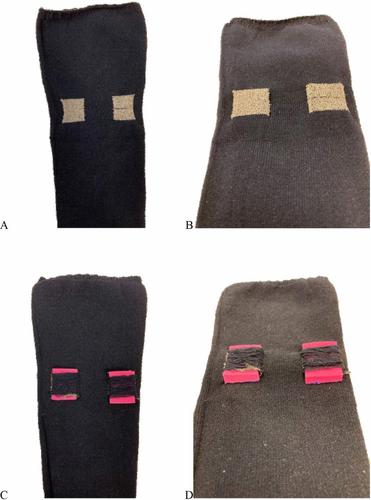European Journal of Applied Physiology ( IF 2.8 ) Pub Date : 2023-05-05 , DOI: 10.1007/s00421-023-05212-5 C Sundström 1 , R Juthberg 1 , J Flodin 1 , L Guo 2 , N-K Persson 2 , P W Ackermann 1, 3

|
Purpose
To compare fixed transverse textile electrodes (TTE) knitted into a sock versus motor point placed standard gel electrodes (MPE) on peak venous velocity (PVV) and discomfort, during calf neuromuscular electrical stimulation (calf-NMES).
Methods
Ten healthy participants received calf-NMES with increasing intensity until plantar flexion (measurement level I = ML I), and an additional mean 4 mA intensity (ML II), utilizing TTE and MPE. PVV was measured with Doppler ultrasound in the popliteal and femoral veins at baseline, ML I and II. Discomfort was assessed with a numerical rating scale (NRS, 0–10). Significance was set to p < 0.05.
Results
TTE and MPE both induced significant increases in PVV from baseline to ML I and significantly higher increases to ML II, in both the popliteal and femoral veins (all p < 0.001). The popliteal increases of PVV from baseline to both ML I and II were significantly higher with TTE versus MPE (p < 0.05). The femoral increases of PVV from baseline to both ML I and II were not significantly different between TTE and MPE. TTE versus MPE resulted at ML I in higher mA and NRS (p < 0.001), and at ML II in higher mA (p = 0.005) while NRS was not significantly different.
Conclusion
TTE integrated in a sock produces intensity-dependent increases of popliteal and femoral hemodynamics comparable to MPE, but results in more discomfort at plantar flexion due to higher current required. TTE exhibits in the popliteal vein higher increases of PVV compared to MPE.
Trial registration
Trial_ID: ISRCTN49260430. Date: 11/01/2022. Retrospectively registered.
中文翻译:

集成在袜子中的新型纺织电极在小腿神经肌肉电刺激过程中对血流动力学增强和不适的影响
目的
为了比较编织成袜子的固定横向纺织电极 (TTE) 与在小腿神经肌肉电刺激 (小腿-NMES) 期间放置标准凝胶电极 (MPE) 时的峰值静脉速度 (PVV) 和不适感的运动点。
方法
10 名健康参与者接受小腿 NMES,强度不断增加直至跖屈(测量水平 I = ML I),并利用 TTE 和 MPE 接受额外的平均 4 mA 强度 (ML II)。在基线、ML I 和 II 处用多普勒超声测量腘静脉和股静脉的 PVV。通过数字评定量表(NRS,0-10)评估不适感。显着性设置为p < 0.05。
结果
TTE 和 MPE 均诱导腘静脉和股静脉中 PVV 从基线到 ML I 的显着增加,以及到 ML II 的显着更高增加(所有p < 0.001)。TTE 与 MPE 相比,PVV 从基线到 ML I 和 II 的腘窝增加显着更高 ( p < 0.05)。TTE 和 MPE 之间股骨 PVV 从基线到 ML I 和 II 的增加没有显着差异。TTE 与 MPE 相比,ML I 时的 mA 和 NRS 较高(p < 0.001),ML II 时的 mA 较高(p = 0.005),而 NRS 没有显着差异。
结论
与 MPE 相比,集成在袜子中的 TTE 会产生强度依赖性的腘窝和股骨血流动力学增加,但由于需要更高的电流,导致跖屈时更加不适。与 MPE 相比,TTE 在腘静脉中表现出更高的 PVV 增加。
试用注册
试用 ID:ISRCTN49260430。日期:2022 年 11 月 1 日。已追溯登记。


















































 京公网安备 11010802027423号
京公网安备 11010802027423号